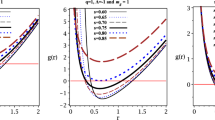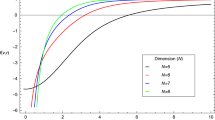Abstract
We study extremal black hole solutions of the S3 model (obtained by setting S=T=U in the STU model) using group theoretical methods. Upon dimensional reduction over time, the S3 model exhibits the pseudo-Riemannian coset structure \( {{G} \left/ {{\tilde{K}}} \right.} \) with G = G2(2) and \( \tilde{K} = {\text{S}}{{\text{O}}_0}\left( {2,2} \right) \). We study nilpotent \( \tilde{K} \)-orbits of G2(2) corresponding to non-rotating single-center extremal solutions. We find six such distinct \( \tilde{K} \)-orbits. Three of these orbits are supersymmetric, one is non-supersymmetric, and two are unphysical. We write general solutions and discuss examples in all four physical orbits. We show that all solutions in supersymmetric orbits when uplifted to five-dimensional minimal supergravity have single-center Gibbons-Hawking space as their four-dimensional Euclidean hyper-Kähler base space. We construct hitherto unknown extremal (supersymmetric as well as non-supersymmetric) pressureless black strings of minimal five-dimensional supergravity and briefly discuss their relation to black rings.
Similar content being viewed by others
References
S. Ferrara, R. Kallosh and A. Strominger, N = 2 extremal black holes, Phys. Rev. D 52 (1995) 5412 [hep-th/9508072] [SPIRES].
S. Ferrara and R. Kallosh, Universality of supersymmetric attractors, Phys. Rev. D 54 (1996) 1525 [hep-th/9603090] [SPIRES].
S. Ferrara, G.W. Gibbons and R. Kallosh, Black holes and critical points in moduli space, Nucl. Phys. B 500 (1997) 75 [hep-th/9702103] [SPIRES].
A. Sen, Black hole entropy function and the attractor mechanism in higher derivative gravity, JHEP 09 (2005) 038 [hep-th/0506177] [SPIRES].
K. Goldstein, N. Iizuka, R.P. Jena and S.P. Trivedi, Non-supersymmetric attractors, Phys. Rev. D 72 (2005) 124021 [hep-th/0507096] [SPIRES].
A. Ceresole and G. Dall’Agata, Flow equations for non-BPS extremal black holes, JHEP 03 (2007) 110 [hep-th/0702088] [SPIRES].
L. Andrianopoli, R. D’Auria, E. Orazi and M. Trigiante, First order description of black holes in moduli space, JHEP 11 (2007) 032 [arXiv:0706.0712] [SPIRES].
G. Lopes Cardoso, A. Ceresole, G. Dall’Agata, J.M. Oberreuter and J. Perz, First-order flow equations for extremal black holes in very special geometry, JHEP 10 (2007) 063 [arXiv:0706.3373] [SPIRES].
J. Perz, P. Smyth, T. Van Riet and B. Vercnocke, First-order flow equations for extremal and non-extremal black holes, JHEP 03 (2009) 150 [arXiv:0810.1528] [SPIRES].
K. Hotta and T. Kubota, Exact solutions and the attractor mechanism in non-BPS black holes, Prog. Theor. Phys. 118 (2007) 969 [arXiv:0707.4554] [SPIRES].
E.G. Gimon, F. Larsen and J. Simon, Black holes in supergravity: the non-BPS branch, JHEP 01 (2008) 040 [arXiv:0710.4967] [SPIRES].
S. Bellucci, S. Ferrara, A. Marrani and A. Yeranyan, stu black holes unveiled, arXiv:0807.3503 [SPIRES].
E.G. Gimon, F. Larsen and J. Simon, Constituent model of extremal non-BPS black holes, JHEP 07 (2009) 052 [arXiv:0903.0719] [SPIRES].
G. Bossard, Y. Michel and B. Pioline, Extremal black holes, nilpotent orbits and the true fake superpotential, JHEP 01 (2010) 038 [arXiv:0908.1742] [SPIRES].
G. Bossard, H. Nicolai and K.S. Stelle, Universal BPS structure of stationary supergravity solutions, JHEP 07 (2009) 003 [arXiv:0902.4438] [SPIRES].
G. Bossard and H. Nicolai, Multi-black holes from nilpotent Lie algebra orbits, Gen. Rel. Grav. 42 (2010) 509 [arXiv:0906.1987] [SPIRES].
M. Günaydin, A. Neitzke, B. Pioline and A. Waldron, BPS black holes, quantum attractor flows and automorphic forms, Phys. Rev. D 73 (2006) 084019 [hep-th/0512296] [SPIRES].
M. Berkooz and B. Pioline, 5D black holes and non-linear σ-models, JHEP 05 (2008) 045 [arXiv:0802.1659] [SPIRES].
D. Gaiotto, W.W. Li and M. Padi, Non-supersymmetric attractor flow in symmetric spaces, JHEP 12 (2007) 093 [arXiv:0710.1638] [SPIRES].
E. Bergshoeff, W. Chemissany, A. Ploegh, M. Trigiante and T. Van Riet, Generating geodesic flows and supergravity solutions, Nucl. Phys. B 812 (2009) 343 [arXiv:0806.2310] [SPIRES].
J.P. Gauntlett, J.B. Gutowski, C.M. Hull, S. Pakis and H.S. Reall, All supersymmetric solutions of minimal supergravity in five dimensions, Class. Quant. Grav. 20 (2003) 4587 [hep-th/0209114] [SPIRES].
F. Larsen, Entropy of thermally excited black rings, JHEP 10 (2005) 100 [hep-th/0505152] [SPIRES].
J.M. Maldacena, A. Strominger and E. Witten, Black hole entropy in M-theory, JHEP 12 (1997) 002 [hep-th/9711053] [SPIRES].
I. Bena, Splitting hairs of the three charge black hole, Phys. Rev. D 70 (2004) 105018 [hep-th/0404073] [SPIRES].
H. Elvang, R. Emparan, D. Mateos and H.S. Reall, A supersymmetric black ring, Phys. Rev. Lett. 93 (2004) 211302 [hep-th/0407065] [SPIRES].
H. Elvang, A charged rotating black ring, Phys. Rev. D 68 (2003) 124016 [hep-th/0305247] [SPIRES].
R. Emparan, Rotating circular strings and infinite non-uniqueness of black rings, JHEP 03 (2004) 064 [hep-th/0402149] [SPIRES].
H. Elvang and R. Emparan, Black rings, supertubes and a stringy resolution of black hole non-uniqueness, JHEP 11 (2003) 035 [hep-th/0310008] [SPIRES].
R. Emparan, T. Harmark, V. Niarchos and N.A. Obers, World-volume effective theory for higher-dimensional black holes, Phys. Rev. Lett. 102 (2009) 191301 [arXiv:0902.0427] [SPIRES].
P. Breitenlohner, D. Maison and G.W. Gibbons, Four-dimensional black holes from Kaluza-Klein theories, Commun. Math. Phys. 120 (1988) 295 [SPIRES].
P. Dobiasch and D. Maison, Stationary, spherically symmetric solutions of Jordan’S unified theory of gravity and electromagnetism, Gen. Rel. Grav. 14 (1982) 231 [SPIRES].
M.J. Duff, J.T. Liu and J. Rahmfeld, Four-dimensional string-string-string triality, Nucl. Phys. B 459 (1996) 125 [hep-th/9508094] [SPIRES].
E. Cremmer, B. Julia, H. Lü and C.N. Pope, Higher-dimensional origin of D = 3 coset symmetries, hep-th/9909099 [SPIRES].
A. Ceresole, R. D’Auria, S. Ferrara and A. Van Proeyen, Duality transformations in supersymmetric Yang-Mills theories coupled to supergravity, Nucl. Phys. B 444 (1995) 92 [hep-th/9502072] [SPIRES].
G. Compere, S. de Buyl, E. Jamsin and A. Virmani, G 2 dualities in D = 5 supergravity and black strings, Class. Quant. Grav. 26 (2009) 125016 [arXiv:0903.1645] [SPIRES].
G. Bossard, H. Nicolai and K.S. Stelle, Gravitational multi-NUT solitons, Komar masses and charges, Gen. Rel. Grav. 41 (2009) 1367 [arXiv:0809.5218] [SPIRES].
G.W. Gibbons and P.J. Ruback, The hidden symmetries of multicenter metrics, Commun. Math. Phys. 115 (1988) 267 [SPIRES].
G.W. Gibbons and S.W. Hawking, Gravitational multi -instantons, Phys. Lett. B 78 (1978) 430 [SPIRES].
H. Elvang, R. Emparan, D. Mateos and H.S. Reall, Supersymmetric 4D rotating black holes from 5D black rings, JHEP 08 (2005) 042 [hep-th/0504125] [SPIRES].
D. Collingwood and W. McGovern, Nilpotent orbits in semisimple lie algebras, Van Nostrand Reinhold Mathematics Series (1993).
D. Djokovic, Classification of nilpotent elements in simple exceptional real Lie algebras of inner type and description of their centralizers, J. Alg. 112 (1987) 503.
R. Kallosh and B. Kol, E 7 symmetric area of the black hole horizon, Phys. Rev. D 53 (1996) 5344 [hep-th/9602014] [SPIRES].
S. Giusto and S.D. Mathur, Geometry of D1 – D5 – P bound states, Nucl. Phys. B 729 (2005) 203 [hep-th/0409067] [SPIRES].
I. Bena and N.P. Warner, Bubbling supertubes and foaming black holes, Phys. Rev. D 74 (2006) 066001 [hep-th/0505166] [SPIRES].
P. Berglund, E.G. Gimon and T.S. Levi, Supergravity microstates for BPS black holes and black rings, JHEP 06 (2006) 007 [hep-th/0505167] [SPIRES].
D. Gaiotto, A. Strominger and X. Yin, New connections between 4D and 5D black holes, JHEP 02 (2006) 024 [hep-th/0503217] [SPIRES].
M. Shmakova, Calabi-Yau black holes, Phys. Rev. D 56 (1997) 540 [hep-th/9612076] [SPIRES].
R.C. Myers, Stress tensors and Casimir energies in the AdS/CFT correspondence, Phys. Rev. D 60 (1999) 046002 [hep-th/9903203] [SPIRES].
H. Elvang, R. Emparan and P. Figueras, Non-supersymmetric black rings as thermally excited supertubes, JHEP 02 (2005) 031 [hep-th/0412130] [SPIRES].
G. Compere, S. de Buyl, E. Jamsin and A. Virmani, A general black string and its microscopics,[arXiv:1006.5464] [SPIRES].
L. Houart, A. Kleinschmidt, J. Lindman Hornlund, D. Persson and N. Tabti, Finite and infinite-dimensional symmetries of pure N = 2 supergravity in D = 4, JHEP 08 (2009) 098 [arXiv:0905.4651] [SPIRES].
D. Rasheed, The rotating dyonic black holes of Kaluza-Klein theory, Nucl. Phys. B 454 (1995) 379 [hep-th/9505038] [SPIRES].
F. Larsen, Rotating Kaluza-Klein black holes, Nucl. Phys. B 575 (2000) 211 [hep-th/9909102] [SPIRES].
K. Goldstein and S. Katmadas, Almost BPS black holes, JHEP 05 (2009) 058 [arXiv:0812.4183] [SPIRES].
P. Figueras, E. Jamsin, J.V. Rocha and A. Virmani, Integrability of five dimensional minimal supergravity and charged rotating black holes, Class. Quant. Grav. 27 (2010) 135011 [arXiv:0912.3199] [SPIRES].
Author information
Authors and Affiliations
Corresponding author
Additional information
ArXiv ePrint: 1004.5242
Rights and permissions
About this article
Cite this article
Kim, SS., Lindman Hörnlund, J., Palmkvist, J. et al. Extremal solutions of the S3 model and nilpotent orbits of G2(2) . J. High Energ. Phys. 2010, 72 (2010). https://doi.org/10.1007/JHEP08(2010)072
Received:
Accepted:
Published:
DOI: https://doi.org/10.1007/JHEP08(2010)072




